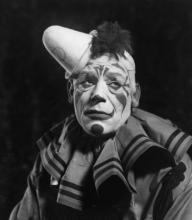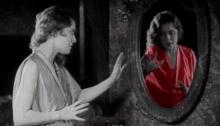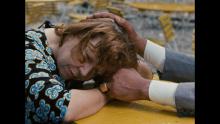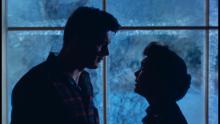This essay on Herbert Brenon's Laugh, Clown, Laugh (1928) were written by Tim Brayton, PhD candidate in the Department of Communication Arts at UW-Madison. A 35mm print of Laugh, Clown, Laugh will screen with live piano accompaniment by David Drazin on Saturday, October 20 at 7 p.m., as the second program in our "Silents Please!" series. The screening takes place in our regular venue, 4070 Vilas Hall. Free admission!
By Tim Brayton
Ruggero Leoncavallo’s 1892 opera Pagliacci is a bitter, raging tragedy about a love affair ending in murder at the hands of a jealous husband. The 1928 feature film Laugh, Clown, Laugh, ultimately based on the opera – via a 1923 play in English, based upon a 1919 play in Italian, itself based upon the opera – is no less tragic, though it is far less bitter. Unlike the appealingly torrid opera, the film’s sorrows are almost entirely internal, its tragedy that of a man coming to grips with the knowledge that the world doesn’t care if he’s sad and old and alone.
So, a perfect scenario for silent cinema, with its singular ability to focus on the expressive powers of the human face. And a perfect scenario for Lon Chaney, whose face was expressive even by the standards of the late silent period. Though today we mostly associate Chaney with his skull-faced Phantom of the Opera, or his soulfully grotesque Quasimodo, hunchback of Notre Dame, more of Chaney’s career was in weepy character dramas, of a sort that Laugh, Clown, Laugh exemplifies. The role of an aging sad-sack who fruitlessly longs for hopeless love was a stock Chaney figure in the ‘20s, meaning that in this late-career role (he appeared in only five more features before his death at age 47), he’d had years of practice refining this character type. That experience pays off, with Chaney giving perhaps his own greatest performance, and one of the great tear-jerking screen turns of the era.
The plot is old-fashioned in its unabashed embrace of melodrama (and, we must confess, its sexual politics): an itinerant clown, Tito (Chaney), takes in an abandoned child, Simonetta. Years later, after she’s grown to adulthood (embodied by 14-year-old future movie star Loretta Young, in her first screen performance), Tito finds himself romantically obsessed with her, but he’s outmatched by Count Luigi Ravelli (Nils Asther), who is younger, handsomer, richer, and not her adopted father. The film leaves little doubt as to the outcome: even Tito recognizes from the start that he’s a totally inappropriate match for Simonetta, that he’s a bit pathetic even for fantasizing about it. This pathos is precisely the fuel of the film’s tragic melodrama, as we watch the middle-aged man grapple with his knowledge of the inevitability of his own loneliness, all while being forced to put on make-up and dance around for the mindless entertainment of audiences.
The irony is not applied with a light touch: signs declaring “Ridi, Pagliaccio” (“laugh, clown”, a key line from the opera’s most famous aria) abound, and the film boasts an angry anti-joke when Tito’s psychiatrist recommends that he should go to see the great clown Flik to cheer himself up, not knowing that Tito is Flik. What keeps Laugh, Clown, Laugh from feeling heavy-handed is partially the medium itself, and the almost mystical effect of silent cinema. If the emotions are drawn with a broad brush, this feels somehow not merely right, but necessary, as though Tito’s pain which cannot be expressed in spoken words must erupt out of his body somehow.
Laugh, Clown, Laugh came out in the last great year of silent cinema. The Jazz Singer had just been a massive hit, and the first all-talking picture, Lights of New York, was just three months in the future. The silent features of 1928 thus represent the last flourishing of a sophisticated, mature art form, and while this film lacks the tremendous innovation of The Crowd or The Wind, it nevertheless demonstrates much of that sophistication. The film was directed by Herbert Brenon, well-regarded in his day by critics (if not always by actors; by Young’s account, Chaney spent this film’s production constantly protecting her from Brenon’s verbal abuse), though many of his films have been lost: even this film is missing one of its reels, though the story is little affected as a result. He brings to the film, with the great cinematographer James Wong Howe, a complex mixture of close-ups and deep spaces, positioning characters against fully three-dimensional spaces like they’ve been dropped into dollhouse rooms, busy with bits and pieces of design. At the same time, the staging rarely allows the characters to fully navigate that space, except inasmuch as different layers of depth are used to keep them separated. The result is a busy, fleshed-out world that feels constantly separated from Tito, amplifying our impression that he is fundamentally alone.
It always comes back to Tito. The film’s beautiful cinematography, Young’s self-assured debut, and everything else notwithstanding, the film that lives and dies entirely on Chaney’s extraordinary work. We see displayed here some of the subtlest make-up he designed in his famous career, silently adding one year after another, exaggerating the wrinkles and whitening hairs. Even his bright white clown make-up, which practically radiates off the screen, changes to reflect time passing. For a film largely about the awareness of a middle-aged man that his time has passed, this never-stressed but omnipresent awareness of the physical toll of aging is heartbreaking in its own right.
Let us never say that Chaney was simply relying on his make-up, though! His work in Laugh, Clown, Laugh is, in this writer’s opinion, one of the great achievements of silent film acting, mixing stereotypically broad poses (to evoke his character’s theatrical background), with tightly constrained facial expressions that shift so gradually as to be nearly invisible. His body language alone imbues the film with an almost unbearable amount of human feeling: consider, for example the way he hangs his arms at his side, rocking his shoulders forward so that it almost seems that his hangdog look is going to pull him to the ground. And then combine the sheer exhaustion and sadness of that pose with Chaney’s skill at slowly allowing tears to form in the corner his eyes while his mouth is set in a curl of self-loathing, a devastating mix of pathos and self-accusation. If this is first and foremost a performance piece, the performance is enough to justify a whole feature: the final masterpiece from one of the quintessential silent film stars.










